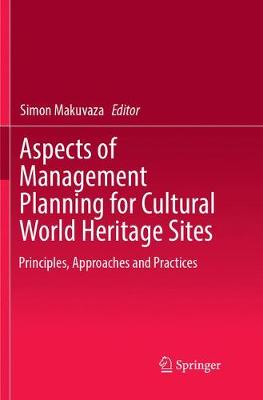Aspects of Management Planning for Cultural World Heritage Sites
 -15%
portes grátis
-15%
portes grátis
Aspects of Management Planning for Cultural World Heritage Sites
Principles, Approaches and Practices
Makuvaza, Simon
Springer International Publishing AG
09/2018
261
Mole
Inglês
9783319888538
15 a 20 dias
454
Descrição não disponível.
Part 1 - Historical Overview.- Chapter 1 - Introduction of Management Planning for Cultural World Heritage Sites.- Chapter 2 - The World Heritage Convention and its Management Concept.- Chapter 3 - The Management Plan for the World Heritage Sites as a Tool of Performance Measurement and Sustainability Reporting: Opportunities and Limits in the Italian Context.- Part 2 - Case Studies.- Chapter 4 - From Archaeological Site to World Heritage Site: The Emergence of Social Management at Monte Alban, Mexico.- Chapter 5 - Head-Smashed-In Buffalo Jump, Canada and Cahokia Mounds State Historic Site, United States.- Chapter 6 - Pragmatic Approaches to World Heritage Management-Along the Central Asian Silk Roads.- Chapter 7 - "Huai hai wei Yangzhou": Site Management Planning and the Establishment of Yangzhou Archaeological Site Park in China.- Chapter 8 - Integrated Management of Archaeological and Rural Landscape: Feasibility Project for Gordion Archaeological Park.- Chapter 9 - Conservation Issues, Management Initiatives and the Challenges for Implementing Khami World Heritage Site Management Plans in Zimbabwe.- Chapter 10 - Concerning Heritage: Lessons from Rock Art Management in the Maloti-Drakensberg Park World Heritage Site.- Chapter 11 - Managing the Rock Art of the uKhahlamba-Drakensberg: Progress, Blind Spots and Challenges.- Chapter 12 - Conservation, Stakeholders and Local Politics: The Management of the Matobo Hills World Heritage Site, South Western Zimbabwe.- Chapter 13 - Stone Circles and Atlantic Forts: Tourism and Management of Gambia's World Heritage Sites.- Chapter 14 - Managing a Hybrid Institution; the Evolving Case of Robben Island World Heritage Site, Western Cape, South Africa.- Chapter 15 - National Identities, New Actors and Management of World Heritage Sites: The Case of Ouro Preto and a Jesuit Mission of the Guaranis in Brazil.- Chapter 16 - The Case Study of the Town of Bamberg (Germany) Concerning the Combination of Management Plans with Participation Strategies in Urban World Heritage Properties.- Part 3 - Analysis, Discussion and Conclusion.- Chapter 17 - Making Sense of Site Management.- Chapter 18 - Governance in UNESCO World Heritage Sites: Reframing the Role of Management Plans as a Tool to Improve Community Engagement.
Este título pertence ao(s) assunto(s) indicados(s). Para ver outros títulos clique no assunto desejado.
preservation of single monuments to wide-ranging sites;evolution of the management of World Heritage properties;active engagement of communities living in and around sites;archaeological sites affected by looting and trafficking;heritage sites and the construction of cultural identities
Part 1 - Historical Overview.- Chapter 1 - Introduction of Management Planning for Cultural World Heritage Sites.- Chapter 2 - The World Heritage Convention and its Management Concept.- Chapter 3 - The Management Plan for the World Heritage Sites as a Tool of Performance Measurement and Sustainability Reporting: Opportunities and Limits in the Italian Context.- Part 2 - Case Studies.- Chapter 4 - From Archaeological Site to World Heritage Site: The Emergence of Social Management at Monte Alban, Mexico.- Chapter 5 - Head-Smashed-In Buffalo Jump, Canada and Cahokia Mounds State Historic Site, United States.- Chapter 6 - Pragmatic Approaches to World Heritage Management-Along the Central Asian Silk Roads.- Chapter 7 - "Huai hai wei Yangzhou": Site Management Planning and the Establishment of Yangzhou Archaeological Site Park in China.- Chapter 8 - Integrated Management of Archaeological and Rural Landscape: Feasibility Project for Gordion Archaeological Park.- Chapter 9 - Conservation Issues, Management Initiatives and the Challenges for Implementing Khami World Heritage Site Management Plans in Zimbabwe.- Chapter 10 - Concerning Heritage: Lessons from Rock Art Management in the Maloti-Drakensberg Park World Heritage Site.- Chapter 11 - Managing the Rock Art of the uKhahlamba-Drakensberg: Progress, Blind Spots and Challenges.- Chapter 12 - Conservation, Stakeholders and Local Politics: The Management of the Matobo Hills World Heritage Site, South Western Zimbabwe.- Chapter 13 - Stone Circles and Atlantic Forts: Tourism and Management of Gambia's World Heritage Sites.- Chapter 14 - Managing a Hybrid Institution; the Evolving Case of Robben Island World Heritage Site, Western Cape, South Africa.- Chapter 15 - National Identities, New Actors and Management of World Heritage Sites: The Case of Ouro Preto and a Jesuit Mission of the Guaranis in Brazil.- Chapter 16 - The Case Study of the Town of Bamberg (Germany) Concerning the Combination of Management Plans with Participation Strategies in Urban World Heritage Properties.- Part 3 - Analysis, Discussion and Conclusion.- Chapter 17 - Making Sense of Site Management.- Chapter 18 - Governance in UNESCO World Heritage Sites: Reframing the Role of Management Plans as a Tool to Improve Community Engagement.
Este título pertence ao(s) assunto(s) indicados(s). Para ver outros títulos clique no assunto desejado.






